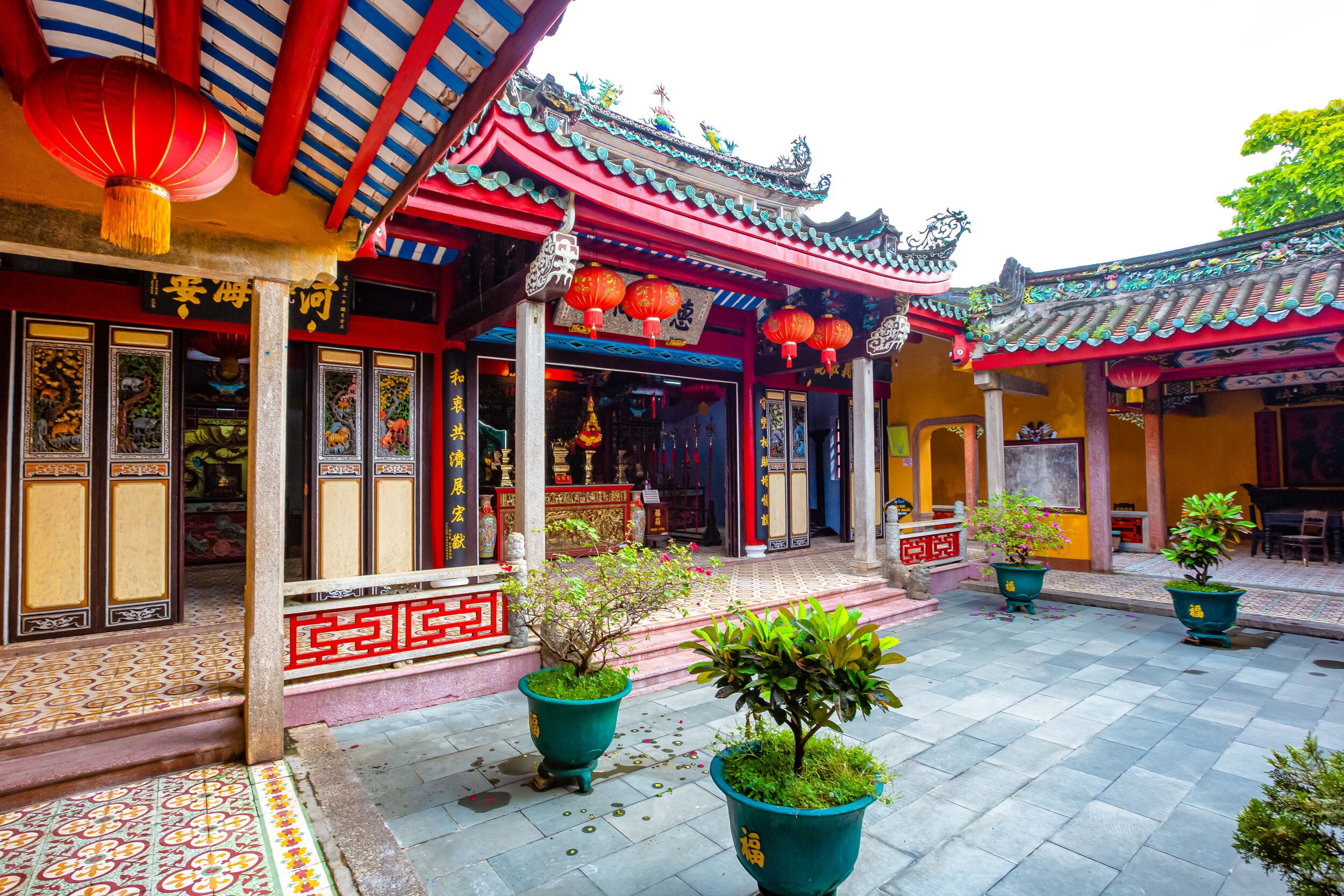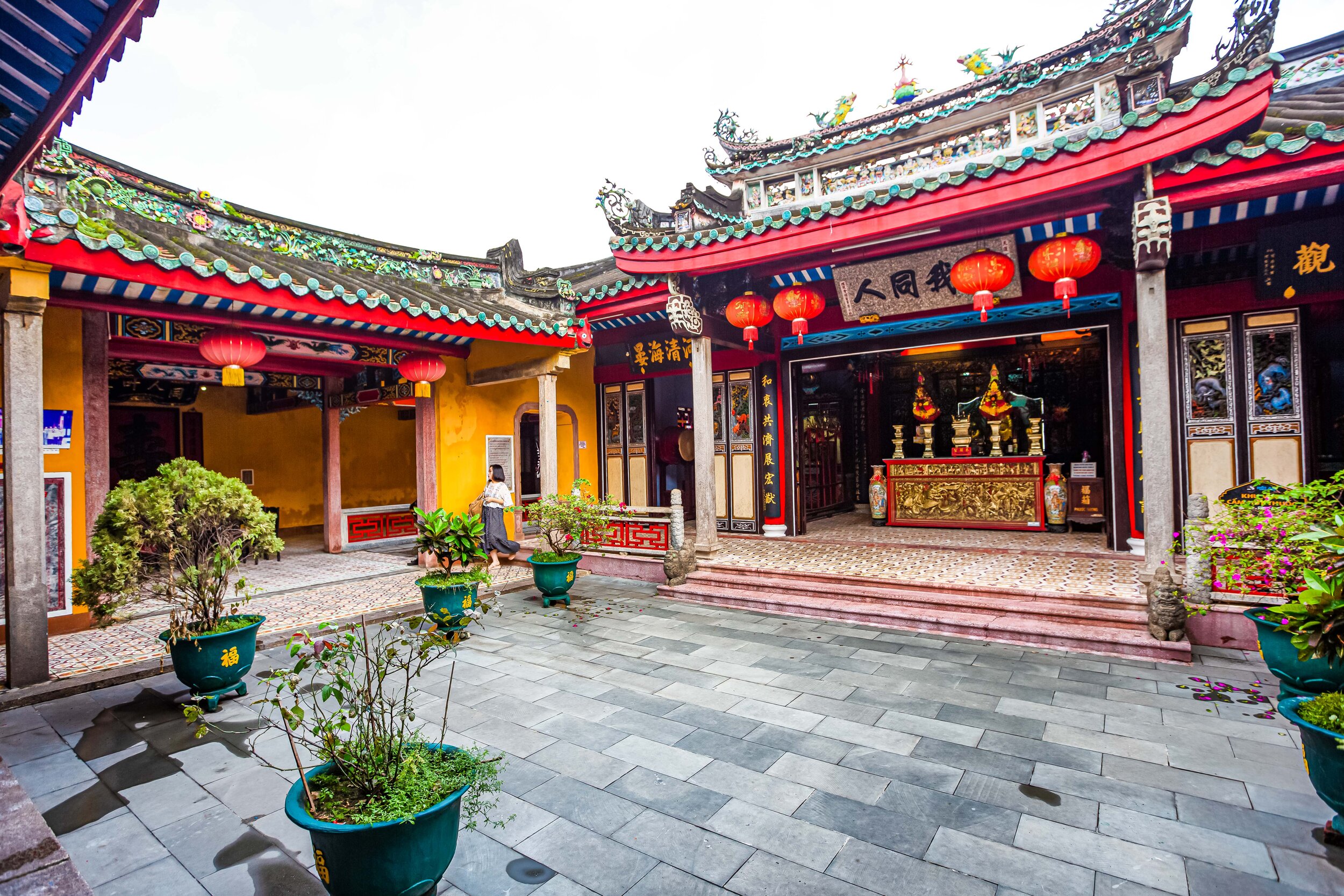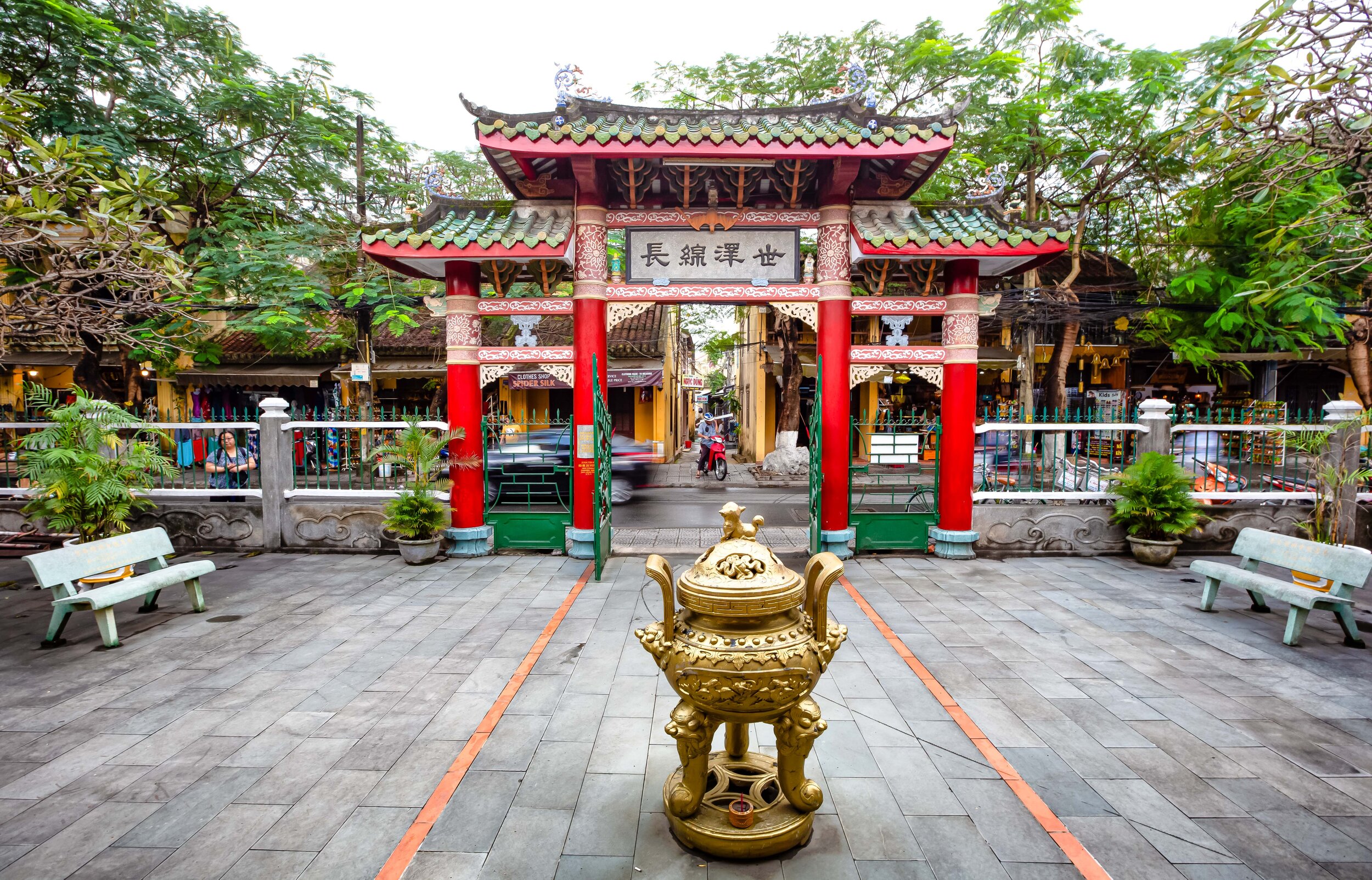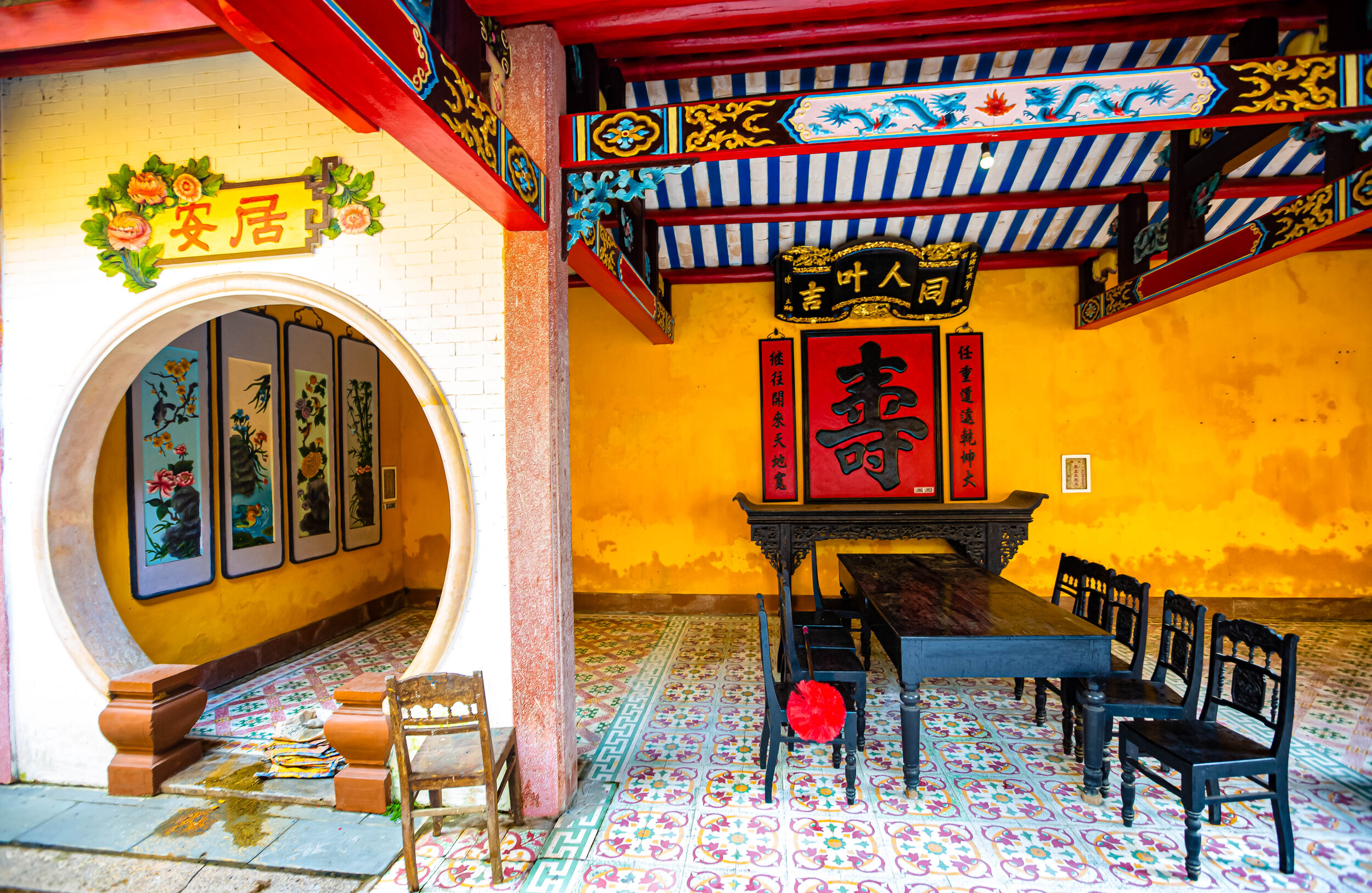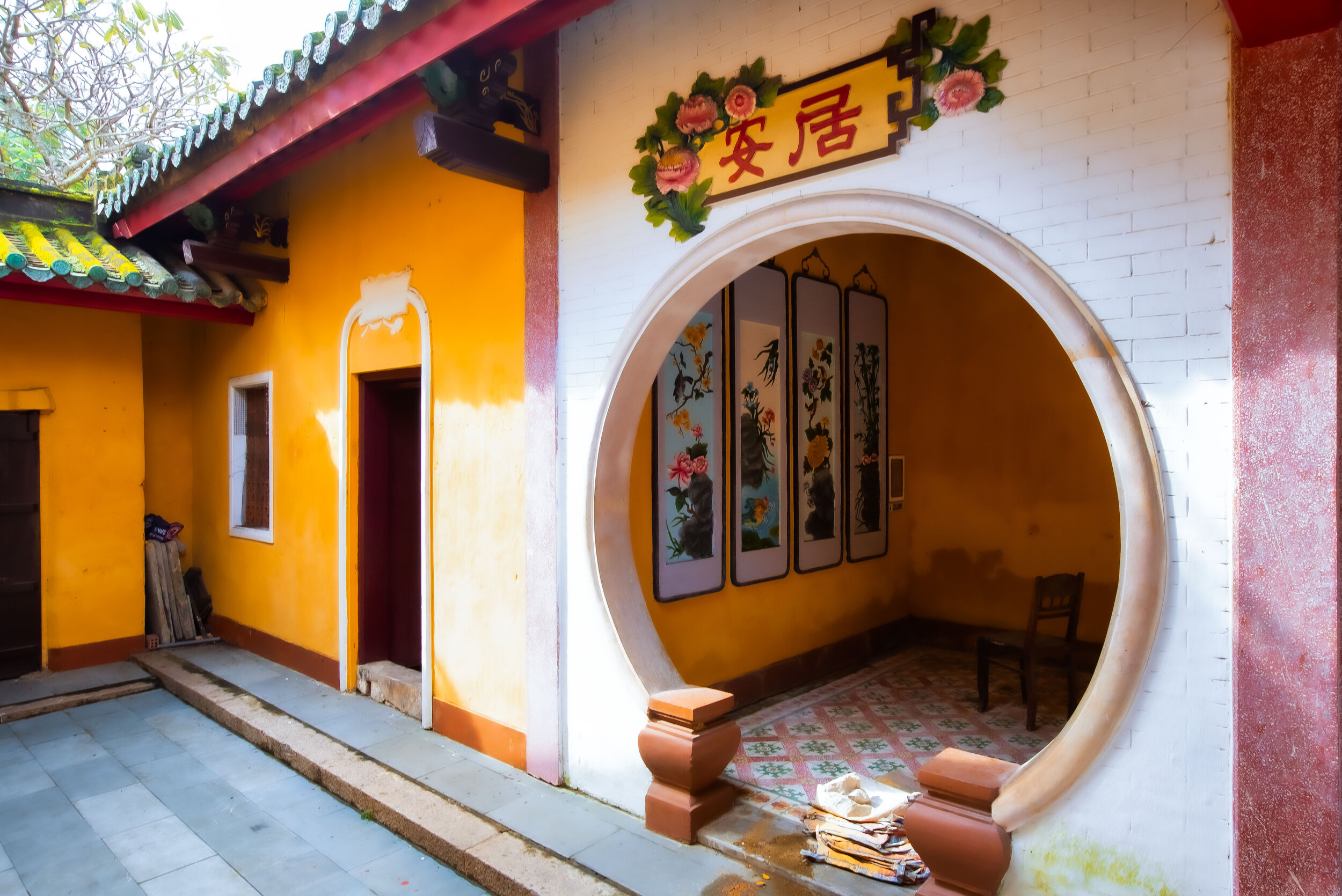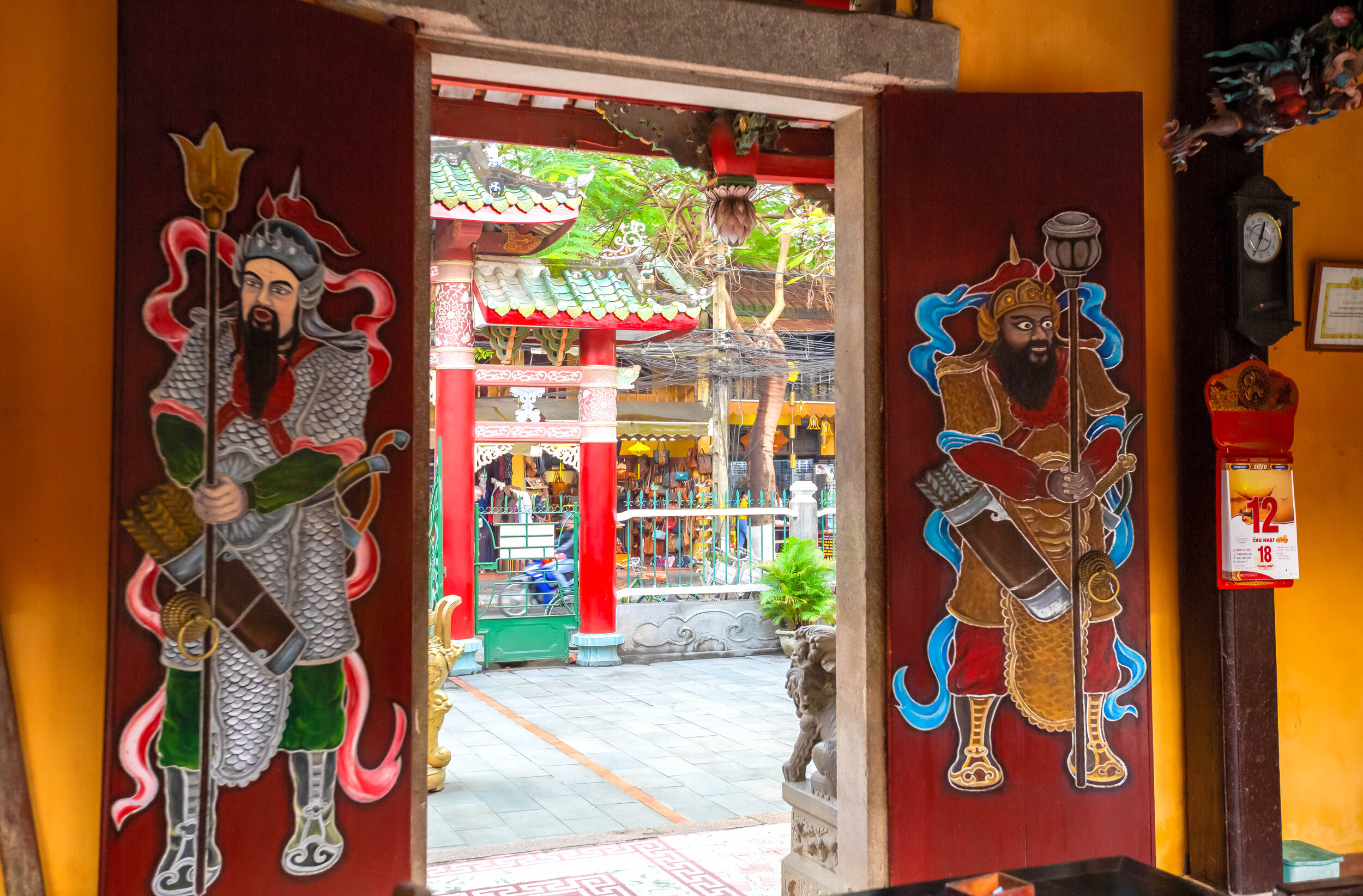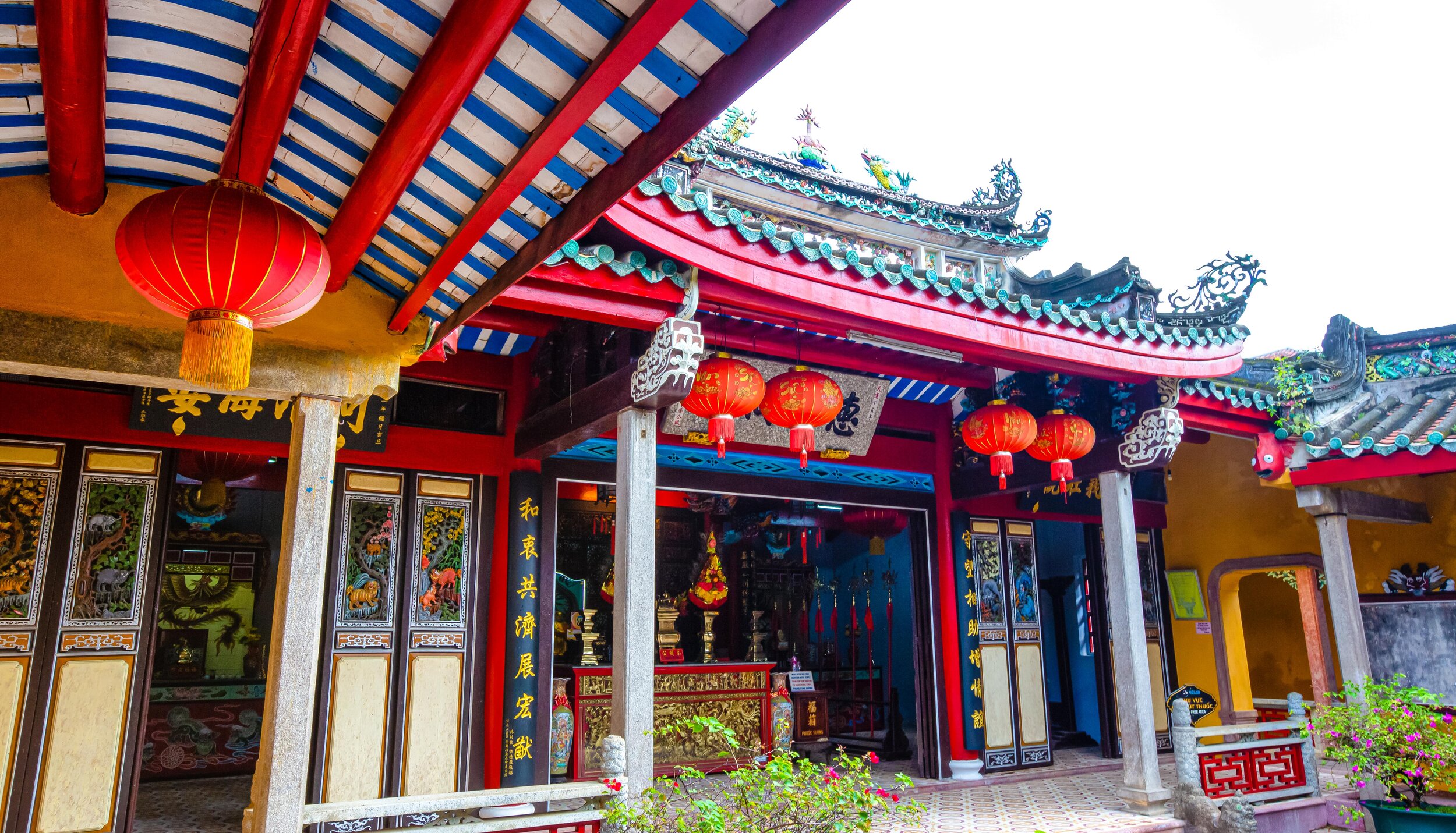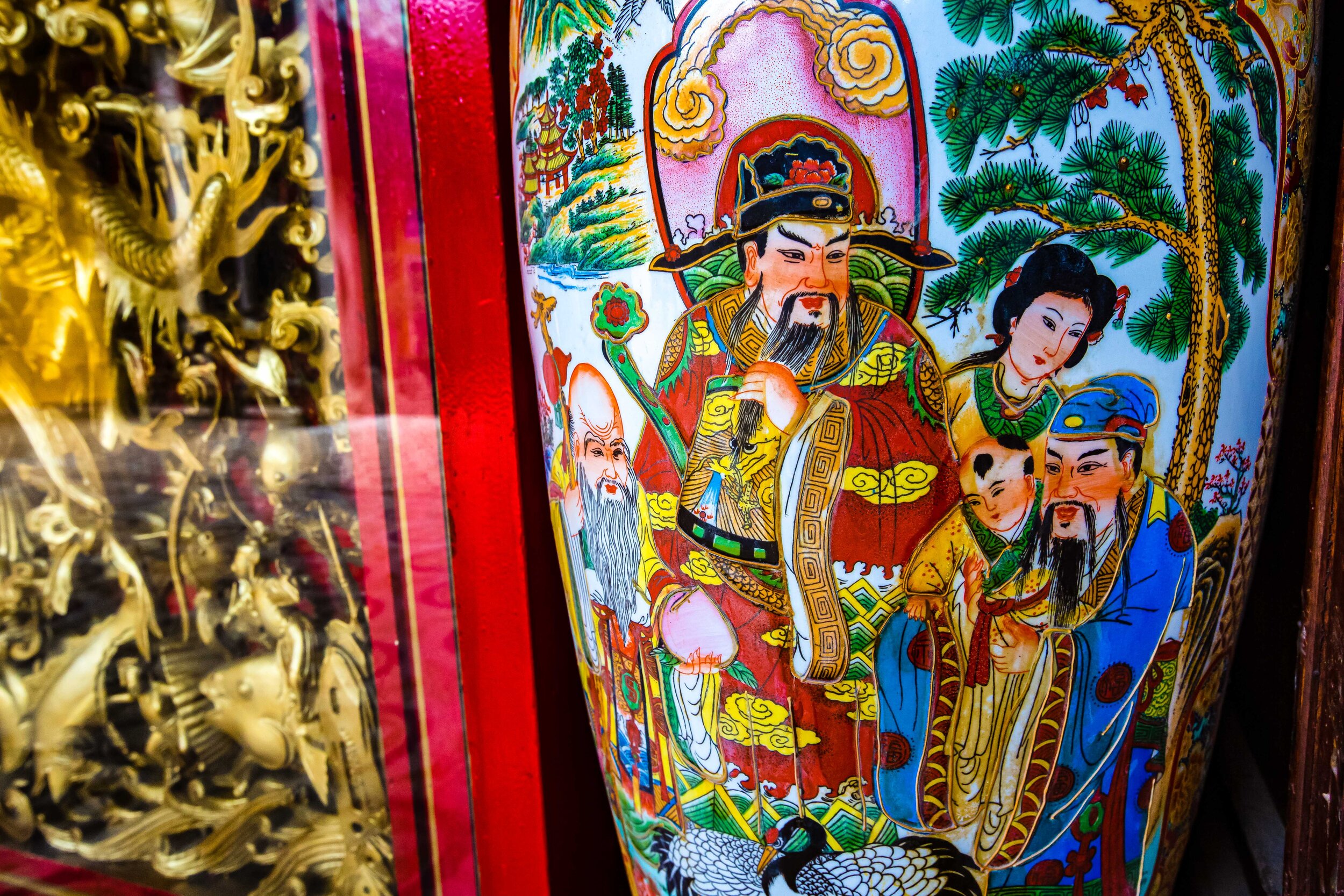While we were planning for our trip to Hoi An, it quickly became obvious that the majority of the locations I was adding to the the itinerary were all historic buildings that could be considered quite similar to those that I’ve become used to exploring here in Taiwan.
The Fujian Assembly Hall for example for the most part could have been a typical temple around here.
I’ve mentioned already a few times in my previous articles that what I was looking forward to most during this trip was in part the familiarity I’d have with what I’m already used to but also how the architecture and design of these halls diverged from what I’m used to here in Taiwan.
I felt like I could still learn quite a bit in the process.
And I did learn quite a bit while visiting the Chaozhou, Fujian, Hainan and Cantonese Assembly Halls.
The history and architecture of these old buildings was really impressive, even for me, someone who spends quite a bit of time exploring historic buildings around Asia.
There was one hall though that admittedly wasn’t on my list before I left for Hoi An and when I happened upon it by chance, I felt extremely fortunate that I didn’t miss out on the opportunity to explore it.
The “Minh Huong Communal Hall” is probably the most unique of all of Hoi An’s Assembly Halls.
Strangely though, when people introduce Hoi An, it rarely ever gets grouped together with the other Assembly Halls and because of that, its almost non-existent on the tourist radar.
It nevertheless has all of the same characteristics of the other halls in town and as far as I’m concerned absolutely should be included on your list of places to visit when you’re in the area.
You might be wondering why this hall gets excluded from the traditional list of Assembly Halls in Hoi An.
That’s actually both a simple and a complicated answer.
The ‘Assembly Halls’ in Hoi An as well as other areas of Vietnam and South East Asia were always constructed to serve specific communities of ‘Overseas Chinese’ immigrants like the Hokkiens, Cantonese, etc.
This one though wasn’t constructed for ‘Overseas Chinese’ - it was built for a special group of people who were of Chinese descent, but held a special status in Vietnam and weren’t considered to be immigrants despite the fact that they were Chinese.
Some people claim that this is the reason why this Assembly Hall is often left off the list of “Chinese Assembly Halls” in Hoi An, but I think that’s a pretty poor reason to exclude it.
I’ll also go as far to say that I guarantee that if you visit this one, you’ll learn a lot more about the history of Hoi An than you will at any of the other Chinese Assembly Halls. So even though it might be considered smaller and less impressive than the others, where it lacks is also where it excels.
The Minh Huong Communal Hall is where I learned the most about Hoi An and its amazing history.
I think that if you visit, you’ll feel the same.
“The Minh Huong” (明鄉人)
The Ming (明朝) ruled China from 1368 until 1644 when the dynasty was overthrown and ultimately replaced by the Qing Dynasty (清朝). Over the span of 276 years and sixteen different emperors, the Ming period became known for its contributions to literature, drama, porcelain and its trade and cultural ties with the outside world.
As far as Chinese history goes, the Ming Dynasty is often one that is looked upon the most favorably.
There are a lot of reasons why the Ming Dynasty is referred to the “Great Ming”, but for the Chinese people, the most important thing to remember (about the Ming and why it is so fondly remembered) is because it was preceded by Mongol-led Yuan Dynasty (元朝) and then overthrown by the Manchu-led (滿族) Qing Dynasty, both of which were considered “foreign”, to say the least.
The Ming Dynasty was essentially the last dynasty that was ruled by the “Chinese” before the modern period.
For a lot of people, especially those in Southern China, when the Ming Dynasty ended, it wasn’t just the end of an era - it was the end of their way of life. So, instead of submitting to the rule of yet another group of non-Chinese, a lot of people decided to simply pack up their things and leave.
Famously, a large military group of these Ming-loyalists arrived here in Taiwan and established a colony (which would later become a kingdom) of their own in the southern area of the island. The Kingdom of Tungning (東寧王國) as it became known was led by the pirate Koxinga (鄭成功), a former navy commander, and existed solely to help restore the Ming.
Even though the so-called ‘kingdom’ only lasted from 1661-1683, it has had lasting effects on the cultural landscape of Taiwan.
For others, emigration was a considerably more difficult process and most of the Ming-loyalists who fled China sufficed to travel south through Vietnam, Cambodia and beyond.
The vast majority of those who left did so fearing reprisal from the new regime as they were connected in some way to the Ming politically or militarily, which also meant that the majority of them were male.
In Vietnam, the Nguyễn lords, who controlled most of the south held an affinity for the Ming and agreed to allow the refugees to freely settle in areas formerly part of the Champa kingdom around Hoi An (會安) where there was already an ethnic-Chinese population.
Initially the refugees were referred to as the “Minh Hương” (明香) or “those who worship the Ming Dynasty”, but in 1827 by royal decree, they were renamed “Minh Hương” (明鄉) which meant “people of Ming origin.”
The reason for this upgrade in status was that many of those refugees (as I mentioned above) were those with special skills and had contributed to the political and economic system in the area for quite some time.
This preferential treatment however had some pros and cons in that they were given tax and business incentives (among other privileges), but also required them to live in communities that segregated them from the overseas Chinese merchants in the area.
Note: It might seem confusing as the Vietnamese name for “Minh Hương” never actually changed, but the way to refer to them in Chinese did. Instead of using “明香” (míng xiāng) they became known as “明鄉” (míng xiāng), which is actually pronounced almost exactly the same but has a separate meaning as “鄉“ refers to the notion of a community
Link: Minh Hương (Wiki) | 明鄉人 (Wiki) | Hoa People (Wiki)
As the Minh Huong people became permanent residents, it was only natural that they started to intermarry with the local people and further integrate into Vietnamese society.
As this took place they started formed their own ethno-cultural identity which allowed them to celebrate their Chinese heritage while at the same time differentiating themselves from the newer waves of Chinese immigrants who came to Vietnam.
That being said, after several generations their links to China gradually started to dissipate and although they maintained some of their cultural traditions, the majority of them preferred to speak Vietnamese rather than Chinese.
In fact, these days the vast majority of the descendants of the Minh Huong people are unable to speak, read or write Chinese - but there is a movement to help rectify these issues, especially among younger generations wanting to learn more about their ancestral heritage.
Today the total population of Minh Huong people in Vietnam is unclear due to the fact that their integration over the past few centuries has made it difficult to record their numbers.
In 1950 it was estimated that there were around 75,000 people of Minh Huong ancestry in Vietnam while today academics claim that there are likely more than a hundred thousand.
The important thing to remember is that the Minh Huong weren’t a homogenous group - They were people who fled from many different areas of China and were grouped together upon arrival in Vietnam based on their loyalty to the Ming Dynasty.
So, in order to keep their special privileges they had to integrate into society while at the same time facing discrimination from later waves of Chinese traders and immigrants who likely considered them traitors and were jealous of their economic privileges.
So, if for example you were a Minh Huong of Cantonese descent and you noticed that there was a newly constructed Cantonese Assembly Hall in town, a visit would have been considered an awkward experience for any number of reasons.
Fortunately, even though the Ming Huong fully integrated themselves into Vietnamese society, one of the similarities that they shared with the other ethnic-Chinese groups was they also constructed their own traditional halls of worship and places where they could get together to network and celebrate their cultural heritage.
As I’ve already mentioned, even though the Minh Huong Communal House (明鄉萃先堂) is rarely ever grouped together with the other Chinese Association Halls in Hoi An, I don’t really see much of a point in separating them. The Communal Hall plays a similar role and serves the same purpose as a place to get together, worship and celebrate ones culture and heritage.
Unfortunately due to the fact that most travel information about Hoi An tends to differentiate the Communal House from the Association Halls, there is very little information about this one available online.
I hope that this helps out and also convinces you to visit!
Minh Hương Tụy Tiên Đường (明鄉萃先堂)
The “Minh Hương Tụy Tiên Đường” or simply the “Minh Huong Communal House” is one of the many tourist destinations within the historic heritage town of Hoi An. Recognized as a National Historic Cultural Relic in 1993, it underwent a period of restoration from 2002 to 2009 with funds from the national government and is today open to the public for tourism.
The history of the hall however is a little bit confusing and there is certainly quite a lot of misinformation and claims about its age found in English-language travel resources.
The reason for the confusion (as far as I can tell) is that while not much has been written about it (in any language), the hall has undergone a considerable amount of changes over its history which has made it difficult to keep track of what’s actually going on inside.
Of particular note is that some of the deities that you’ll find enshrined within the hall are relatively new residents and have been transferred there from other Minh Huong places of worship in Hoi An.
This is because several historic Minh Huong places of worship have already been torn down to make way for new developments.
So, with little written about the hall, it’s not easy to actually report accurate historical information.
The date of its construction is unclear, but it appears that the establishment of the hall dates back to the mid-17th century. The reason why the dates of the halls origins are confusing for most people is because they fail to realize that the location that we can visit today wasn’t the original location of the hall.
The best estimate that we have for this particular hall is that it moved to its current location and was opened in 1820.
Note: I realize that this might seem a bit confusing, but when it comes to historic Chinese structures like this, its important to remember that the year it was “established” and the year it was “constructed” or often “reconstructed” are not actually the same.
I guess you can’t fault people for exaggerating the age of their “historic” buildings just a little.
Historically, the hall was used not only just as a place of worship but also for community outreach, business networking and celebrating cultural events.
It also served as the home of the administrative office of the Minh Huong Village Council for a period of time.
Although the exact date of its construction isn’t all that clear, what we do know is that it was crafted by the people at the famed Hoi An Kim Bong Carpentry Village (金奉木雕村), which for the past several centuries has created some of the most beautiful woodwork in the whole of Vietnam.
The elaborate woodwork at this hall is no different and even after two-centuries and a couple of restoration projects, their work is still in excellent condition and maintains a similar appearance to what you would have seen on the day the hall first opened.
Link: Come to Hoi An to Visit Kim Bong Carpentry Village (Exotic Voyages)
Like the other Assembly Halls and Temples in Hoi An, the front gate and the door to the building face south. The reason for this is that, according to Feng Shui (風水), south represents the element of fire (南方屬火), which means that the building is always going to attract positive energy.
The thing about “fire” energy though is that it’s a strong one for fame and reputation, but to harness that energy, you need a brightly covered entrance which is why the front gate of the hall is beautifully painted yellow - something that you’ll notice is quite common all over Hoi An.
Another important thing to remember about the fire element is that it is sometimes considered to be too strong, so you need to make use of a corresponding element like ‘wood’ (木) or ‘water’ (水) to add some balance - This is why the front courtyard to the hall has trees growing on either side with planted shrubs.
The hall is designed with the traditional ‘two-halls and two protective-dragons’ (兩殿兩護室) style, which simply means that the building is rectangular in shape with a ‘front hall’ (前殿), an open-air courtyard and a ‘main hall’ (正殿) with two ‘protective-dragon’ (護龍) sections connecting the buildings on the eastern and western sides.
From the street you’re met with a beautiful bright yellow four-pillar gate (牌樓) which reads “Minh Huong Communal Hall” (明鄉萃先堂) with a dark red background.
The yellow gate also has a four rows of lanterns on each side which are quite pretty at night.
As I just mentioned, once you walk through the gate you’re met with another courtyard which has some trees and some shrubs planted as decorations. The courtyard simple, but quite pretty and opens directly to the door of the front hall.
As you enter the ‘Front Hall’, you’ll either be met directly by someone wanting your ticket or a shrine with several statues on it. The shrine features not only statues, flowers and a place for worship, but also some beautiful wood-work in the area that surrounds it.
The front hall here isn’t all that large, but there is quite a bit in terms of decoration to notice.
They have spiraled-coils of incense hanging from the ceiling, large vases, floral displays and an area where you can purchase some Chinese zodiac-related trinkets.
The hall is naturally lit, so it can be a bit dark at different times of the day, but the amount of colour they’ve added with their decorations makes it quite pretty.
The existence of a shrine in the front hall is something that makes this specific building stand out from the other Assembly Halls in the area. From my research, it seems like the shrine is relatively new with practical reasons for placing it where it is.
The reason is because even though Hoi An is popular tourist destination, the Minh Huong Communal Hall hasn’t really been able to attract tourists in the same way that some of the other historic buildings have. So, to make up for a bit of lost revenue, they’ve placed some popular deities on the shrine near the front door where they can be seen from the street.
The reason why this is practical is because it helps to attract Chinese tourists (and more importantly donations) which helps to maintain the hall. It’s also quite helpful due to the fact that the main shrine within the temple only really attracts other Minh Huong people for ancestral worship.
The gods in the shrine were chosen for their specific abilities and their importance to both the Minh Huong and your average person of Chinese descent, making it a place where everyone can get together.
From left to right you have:
The Goddess of Childbirth (金花娘娘/註生娘娘)
Thiên Hau, the Goddess of the Sea (天后聖母)
The God of Medicine (藥王本頭公)
The Protector of Life, Emperor Baosheng (保生大帝)
The Earth God (福德正神)
Interestingly, just above the shrine you’ll find a traditional plaque (牌匾) hung from the ceiling that loosely translates as “Perfect Virtue” (明德惟馨). The plaque was gifted to the hall by a group of merchants (五帮眾商) on the anniversary of the founding of the Republic of China (中華民國), which notably marked a decade after the official fall of the Qing Dynasty.
Once you’ve progressed past the front hall, you’ll find the ‘Protective Dragons’ (護龍) on the eastern and western sides of the hall. The ‘dragons’, which are more or less ‘wings’ are used for community-related activities where events are held and people are able to get together for various purposes.
Similar to what you’ll find at the other Assembly Halls in Hoi An, the western side is used for administrative purposes while the eastern side is more or less a large empty space.
Coincidentally while I was visiting the hall there were a couple of local guys sitting at the table, drinking some tea and having a very engaging chat about something that seemed quite important.
The Main Hall (正殿), which is traditionally home to the place of worship in these Assembly Halls is where you’ll find shrines set up for the people who visit the temple to worship.
The thing about this hall is that there is very little written about it, so information about what you’ll find inside is hard to come by - I’ve had to make use of my language skills with English, French and Mandarin to make sense of what little is available, so I hope that what I’ve been able to find is helpful in explaining what you’re going to see when you visit.
The first thing I’ll say is that when you enter the main hall, one of the things you’ll notice is the expert craftsmanship of the wood-work inside. The dark stained wooden doors and the decorations almost glow with the natural light that seeps in on sunny days.
I was especially a fan of the sliding doors which make for great light when you’re taking photos.
There are three shrines in the shrine room, each of which have a statue and ‘spirit plates’ (牌位) in front of them. In this case, the statues are simple representations of spiritual “Civil Servants” (文官) who are known for their literary and intellectual skills concerning governance and business.
The thing that differentiates this place of worship from the other Assembly Halls in town is that the “gods” themselves have been moved to the front hall, so what you’ll find in the main hall here are simple spirit plates representing three important groups of Ming Huong elders.
Suffice to say, the shrines in the main hall are used for Minh Huong ancestral worship and are specifically dedicated to “Thập Đại Lão” (十大老), “Lục Tánh” (六姓) and the “Tam Gia” (三大家), which are entirely unique to this place of worship (and to Hoi An), which is why its not easy to find much information about them.
The “Thập Đại Lão”, otherwise known as the “Ten Elders” are a group of ten of the earliest Minh Huong families that came to the area (around 1644) and include the Khổng (Kong 孔), Nhan (Yan 顏), Dư (Yu 余), Từ (Xu 徐), Chu (Zhou 周), Hoàng (Huang 黃), Trương (Zhang 張), Trần (Chen 陳), Thái (Cai 蔡) and Lưu (Liu 劉) families.
The second group, the “Lục Tánh”, otherwise known as the “Six Families” arrived in the area in 1650 and include the Ngụy (Wei 魏), Trang (Zhuang 莊), Ngô (Wu 吳), Thiệu (Shao 邵), Hứa (Xu 許) and Ngũ (Wu 伍) families.
And finally the “Tam Gia” or the “Three Families” who were headed by Hsi Kuo-hsiang (洗國詳), Wu Ting-kuan (吳廷寬) and Chang Hung-Chi (張弘基) and arrived shortly after the others.
Note: In this case you’ll have to excuse me, I don’t have the actual Vietnamese romanization of their names, so I’ve just converted them into the typical Chinese romanization.
There are also spirit tablets placed for other families and people (27 in total) who showed up in the area later on, but the three main shrines are dedicated to these three groups.
Link: Spirit Tablets (Wiki)
Every year the hall is home to events that the descendants of about sixty families who trace their roots back to the early Minh Huong immigrants attend in order to worship their ancestors and even though its a tourist destination, it is also an important place of worship for the small population of Minh Huong people in Vietnam.
Getting There
Hoi An is a coastal town in Vietnam’s central Quang Nam province that is a 30km drive southeast of neighbouring Da Nang City (峴港市). Since Hoi An has become such a popular destination for travellers, getting to the historic town from Da Nang is quite convenient. Whether you arrive by air through Da Nang International Airport, by train through Da Nang Station or by coach, you’ll be able to easily get yourself to Hoi An through public or private transport, all of which are quite affordable.
While staying in Vietnam, you should also download the “Grab” app for your phone so that you can easily grab a taxi during your travels without having to worry about getting cheated.
Link: Transportation Guide: How to Get from Da Nang to Hoi An
Once you’ve arrived in Hoi An, getting around is really easy - just walk everywhere!
The ‘Old Town’ area of Hoi An that has become a UNESCO World Heritage Site isn’t all that big, and due to so much pedestrian traffic, they’ve blocked the area off from cars, so unless you’re riding a bicycle or a scooter, the best way to get around is on foot.
When you’re ready to start exploring you’ll find that the majority of historic properties, temples, museums and restaurants are located on or between the riverside and Tran Phu Street. What you’ll want to keep in mind though is that exploring the historic properties of Old Town isn’t free, so you’re going to have to purchase an entrance ticket.
The entrance tickets are 120,000 VND (5 USD) per person and gives you access to five sightseeing places. The tickets are valid for the duration of your stay, so if you don’t use all of the tickets on your first day, you’ll still be able to use what you have remaining on the next day.
With so many places to visit within the Old Town though, five tickets might not be enough, so you might have to purchase a second set of tickets if you want to fully experience the town.
Link: Hoi An Old Town Ticket, Entrance Fees & Sites (Hidden Hoi An)
The Minh Hoang Communal House is located on Tran Phu road, the main stretch of Hoi An between the Chaozhou Assembly Hall and the Hainan Assembly Hall. The house is also located close to the Hoi An Market as well as the famous Banh Mi Phuong restaurant.
It is however not located within the central tourist area of Hoi An, so if you plan on visiting, depending on where you’re staying, it could be an extra few minutes of walking to get there.
That area of Hoi An may seem a bit like the ‘outskirts’ of town, but there is actually quite a bit to see and it is in an area that hasn’t received as much attention in terms of restoration thus far. If you visit the home or any of the attractions nearby, you should also try to walk through some of the beautiful alleys across the road where you won’t find many tourists but will find some excellent opportunities for taking great photos. You’ll know you’ve arrived at the communal hall when you’ve found the huge yellow gate, its pretty hard to miss.
Address: 14 Trần Phú, Cẩm Châu, Hội An, Quảng Nam, Vietnam
The hall is open from 8:00 am - 5:00 pm daily.






















